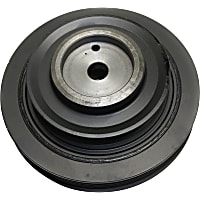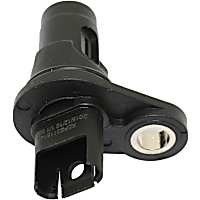One automotive part that frequently gets overlooked is the harmonic balancer (also known as a vibration damper or crankshaft damper). Although the component is often forgotten, when it fails, it can cause major problems—including severe engine damage.
Do you have a sinking feeling that you might have a bad harmonic balancer? If you’re experiencing one or more of the symptoms below, you may be right.
Bad Harmonic Balancer: Signs to Watch Out For
When this component fails, it can cause a range of issues. The most common symptoms of a bad harmonic balancer include:
Engine Vibrations
The harmonic balancer’s job is to dampen vibrations applied to the crankshaft. As a result, when the balancer fails, you may feel a significant vibration from the engine compartment.
Noticeable Harmonic Balancer Wobble
When the rubber isolator begins to deteriorate, the balancer usually begins to separate, creating a noticeable wobble when the engine is running.
Unusual Noises
A faulty balancer can result in a knocking, rattling, or squeaking sound that corresponds with engine speed. In some cases, the noise is bad enough to be mistaken for an internal engine problem.
Also, a balancer that’s beginning to fail can cause abnormal movement from the drive belt or automatic drive belt tensioner, resulting in clicking or squealing noises when the engine is running.
Illuminated Check Engine Light
Your car’s primary computer, which is often referred to as the powertrain control module (PCM), relies on a crankshaft position (CKP) sensor signal to determine crankshaft position and speed.
The CKP sensor reads a toothed or notched wheel that’s usually located on the crankshaft or harmonic balancer. If the harmonic balancer fails, it can cause the sensor to create an abnormal signal, prompting the PCM to turn on the check engine light.
Visible Wear or Damage
If you take a look at the harmonic balancer, you might be able to see visible wear or damage. For example, the rubber insulator may have deteriorated, resulting in a separation between the hub and outer portion of the balancer.

What is a Harmonic Balancer?
So what does a harmonic balancer do? The primary purpose of the balancer is to absorb vibrations applied to the engine’s crankshaft.
With a four-stroke engine, each piston completes four separate strokes—intake, compression, power, and exhaust—while turning the crankshaft. When a piston moves downward during the power stroke, it causes the crankshaft to speed up.
At the same time, another piston is moving upward during the compression stroke, forcing the crankshaft to slow down. As a result, opposing forces are applied to the crankshaft, creating a dangerous resonance phenomenon.
The harmonic balancer moderates the high-frequency vibrations acting on the crankshaft. A typical balancer has a center hub, an inertia ring, and a rubber insulator (some designs use viscous fluid rather than rubber). The center hub is bolted to the end of the crankshaft. As the crankshaft twists and turns, the inertia ring and rubber ring absorb some of the resulting vibrations.
Also, the harmonic balancer has a pulley (either integral or bolted on) that connects to the engine’s drive belt. When the engine is running, the pulley turns the belt, which, in turn, causes the engine-driven accessories (alternator, A/C compressor, etc.) to rotate.
What Happens When a Harmonic Balancer Fails
Although the harmonic balancer may seem simple enough, if it fails, it can cause major problems. Without the balancer dampening unwanted crankshaft vibrations, engine failures, such as worn rod bearings and a broken crankshaft, may result.
A faulty balancer can damage the belt and engine-driven accessories as well. It’s also possible for the balancer to fly apart, resulting in the destruction of a variety of underhood components.
Without a doubt, you should always replace a faulty harmonic balancer right away.
Products Mentioned in this Guide
Any information provided on this Website is for informational purposes only and is not intended to replace consultation with a professional mechanic. The accuracy and timeliness of the information may change from the time of publication.


 Harmonic Balancer
Harmonic Balancer
 Crankshaft Position Sensor
Crankshaft Position Sensor



























Can the HARMONIC BALLANCER cause the power stearing pump to go bad, or leak and make a clicking noise or any other noises?
Hi Gerald,
Although rather uncommon, it’s possible for a failed harmonic balancer to wobble enough to damage the power steering pump via the drive belt.
Thinking this could also be a problem with power steering I’m having power steering seems to be cutting out while driving with the air conditioning on maybe 🤷♂️ Could it be a bearing seizing up putting to much load on the belt
Hello,
If your car’s power steering and A/C are cutting out while driving, the first thing to check is the serpentine belt tension. A worn-out belt or tensioner could be causing the belt to slip.
Can the harmonic balancer cause vibration at highway speeds?
Hello,
If you’re experiencing a vibration at highway speeds, the issue is more likely in the wheels/tires or possibly the drivetrain.
I have a 2.3L Ford with a knock and rattle at idle and goes away when accelerate past 1500rpm. would the dampner pulley cause that?
Hello,
It’s doubtful the balancer is to blame. What is the year and model of your Ford?
2005 ford escape with rattle sound like a screw is bouncing on metal at idoling. Can that be the hormonic balancer?
Hello Karen,
There are many potential causes for the noise, ranging from an exhaust leak to an internal engine concern. However, the harmonic balancer is unlikely to be the problem.
I have a 1996 Nissan Sentra and my harmonic balancer has two pulleys on it. My question is the bigger of the two pulley is able to be moved by hand while connected to the crankshaft. The smaller of the two doesn’t move by hand. My question is. Is it supposed to do that or does it need to be replaced?
Hello,
Harmonic balancers almost always have a press-fit that makes them difficult (or impossible) to remove by hand. The recommended way to remove the balancer is with a dedicated puller tool. But from what you describe, it sounds like the balancer might have come apart. If that’s the case, yes, it will need to be replaced.